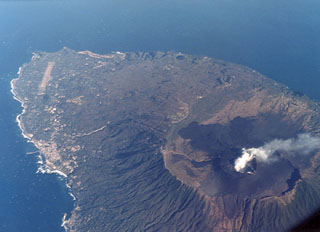Report on Izu-Oshima (Japan) — November 1977
Natural Science Event Bulletin, vol. 2, no. 11 (November 1977)
Managing Editor: David Squires.
Izu-Oshima (Japan) Earthquake swarm in late October through mid-November
Please cite this report as:
Global Volcanism Program, 1977. Report on Izu-Oshima (Japan) (Squires, D., ed.). Natural Science Event Bulletin, 2:11. Smithsonian Institution. https://doi.org/10.5479/si.GVP.NSEB197711-284010
Izu-Oshima
Japan
34.724°N, 139.394°E; summit elev. 746 m
All times are local (unless otherwise noted)
An earthquake swarm [W] of Oshima Island, accompanied by subterranean rumbling, began in late October and was continuing in mid-November (table 1). Similar earthquake swarms occurred in January 1972 and November 1973. Ten minor explosive eruptions have occurred at Oshima since 1962, the latest [in 1974].
Table 1. Number of felt and recorded earthquakes at Oshima, 30 October-17 November 1977. [JMA replaced the data in the original table.]
| Date | Felt Earthquakes | Recorded Earthquakes |
| 30 Oct 1977 | 1 | 79 |
| 31 Oct 1977 | 1 | 217 |
| 04 Nov 1977 | 3 | 43 |
| 15 Nov 1977 | 3 | 86 |
| 16 Nov 1977 | 4 | 243 |
| 17 Nov 1977 | 3 | 242 |
Further Reference. Yamashina, K., and Nakamura, K., 1978, Correlations between tectonic earthquakes and volcanic activity of Izu-Oshima volcano, Japan: JVGR, v. 4, p. 233-250.
Geological Summary. Izu-Oshima volcano in Sagami Bay, east of the Izu Peninsula, is the northernmost of the Izu Islands. The broad, low stratovolcano forms an 11 x 13 km island constructed over the remnants of three older dissected stratovolcanoes. It is capped by a 4-km-wide caldera with a central cone, Miharayama, that has been the site of numerous recorded eruptions datining back to the 7th century CE. More than 40 cones are located within the caldera and along two parallel rift zones trending NNW-SSE. Although it is a dominantly basaltic volcano, strong explosive activity has occurred at intervals of 100-150 years throughout the past few thousand years. A major eruption in 1986 produced spectacular lava fountains up to 1,600 m high and a 16-km-high eruption column; more than 12,000 people were evacuated from the island.
Information Contacts: T. Tiba, National Science Museum, Tokyo.

